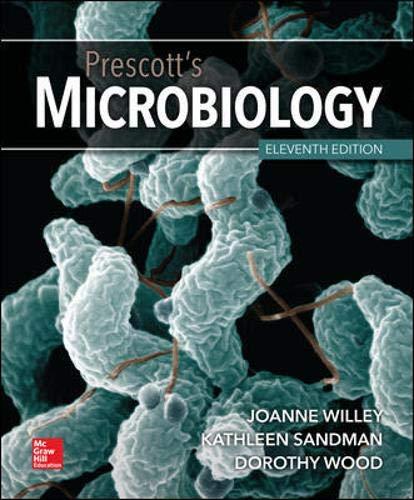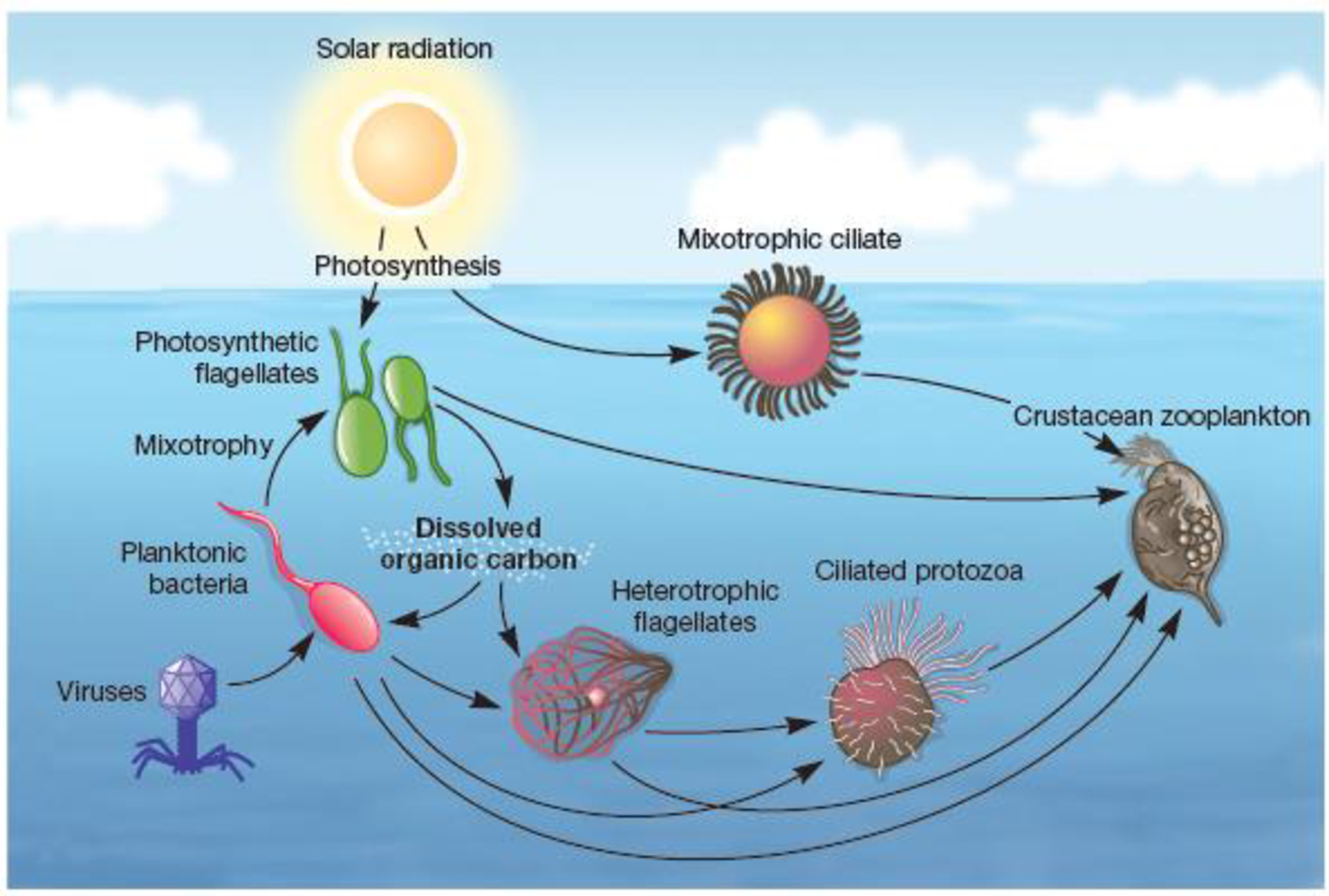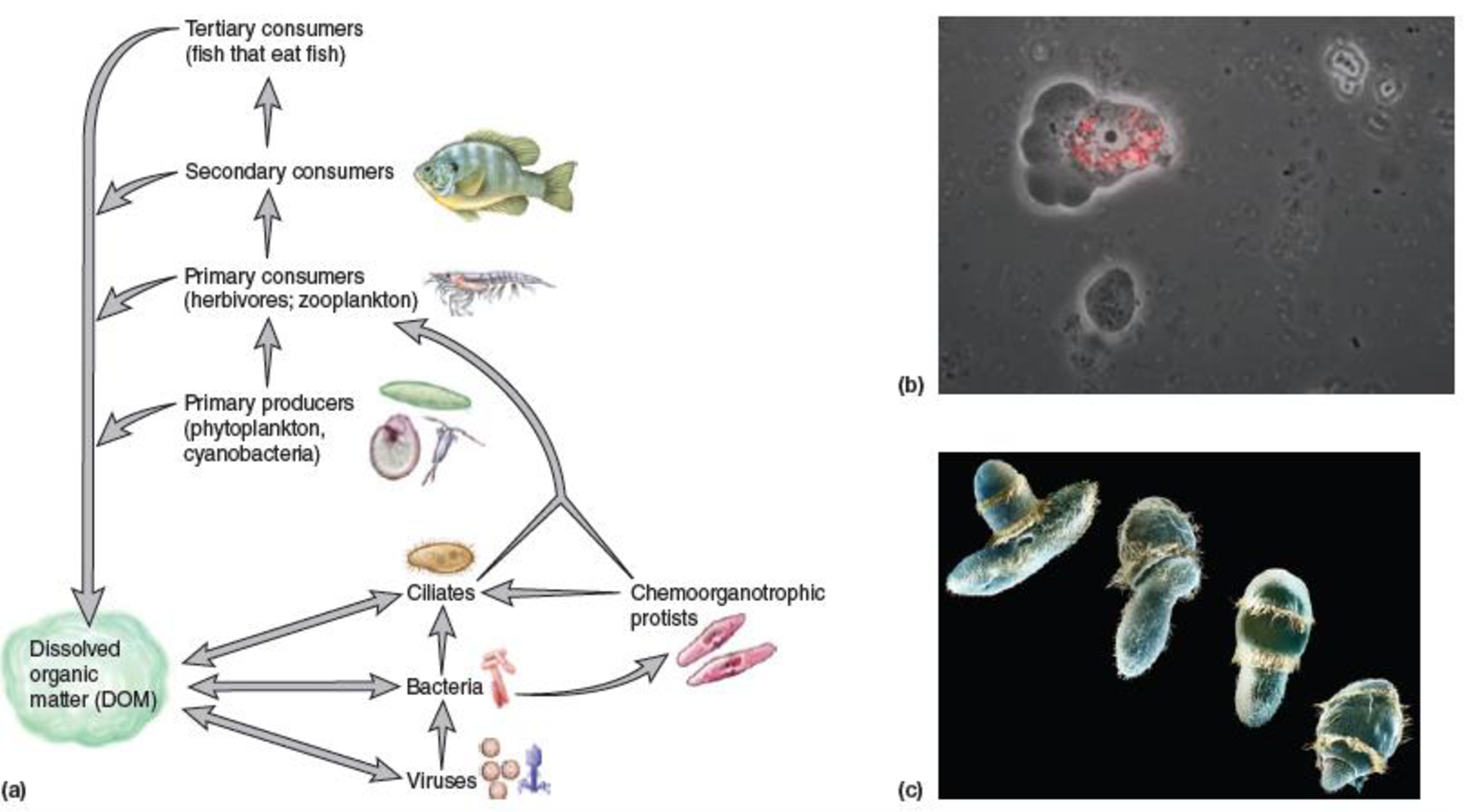
Concept explainers

Figure 30.15 Nutrient Cycling in Antarctic Lakes Is Performed Entirely by Microbes. Antarctic glacial lakes lack multicellular organisms, so all nutrient cycling is between various types of microbes, including bacteriophages. The surrounding environment provides some organic carbon.
List three major differences between this microbial loop and that found in the open ocean (figure 30.6).

Figure 30.6 The Microbial Loop. (a) Microorganisms play vital roles in ecosystems as primary producers, decomposers, and primary consumers. All organisms contribute to a common pool of dissolved organic matter (DOM) that is consumed by microbes. Viruses contribute DOM by lysing their hosts, and bacterial and archaeal cells are consumed by protists, which also consume other protists. These microbes are then consumed by herbivores that often select food items by size, thereby ingesting both heterotrophic and autotrophic microbes. Thus nutrient cycling is a complex system driven in large part by microbes. (b) Protists consume bacteria; in this case, a naked amoeba is consuming the cyanobacterium Synechococcus sp. which fluoresces red. (c) Protists consume protists; here, the ciliate Didinium sp. (rounded organism with two rows of cilia) is preying upon another ciliate, Paramecium sp.
Want to see the full answer?
Check out a sample textbook solution
Chapter 30 Solutions
Prescott's Microbiology
- Figure 46.17 Which of the following statements about the nitrogen cycle is false? Ammonification converts organic nitrogenous matter from living organisms into ammonium (NH4+). Denitrification by bacteria converts nitrates (NO3-) to nitrogen gas (N2). Nitrification by bacteria converts nitrates (NO3 ) to nitrites (NO2-). Nitrogen fixing bacteria convert nitrogen gas (N2) into organic compounds.arrow_forwardFigure 20.12 Which of the following statements about the nitrogen cycle is false? a. Ammonification converts organic nitrogenous matter from living organisms into ammonium (NH4+) . b. Denitrification by bacteria converts nitrates (NO3) to nitrogen gas (N2) . c. Nitrification by bacteria converts nitrates (NO3) to nitrites (NO2) . d. Nitrogen fixing bacteria convert nitrogen gas (N2) into organic compounds.arrow_forwardMatch the following biogeochemical cycles terms to the correct definiton. In this cycle the absorption of this 1. bio-essential element from the atmosphere increases the pH of the oceans. The main reservoir of this nutrient 2. is in the building block for all necessary biomolecules (fats, proteins, and carbohydrates) that constitute an important part of the inorganic matter. The element of this cycle is stored 3. in long-term in Carbonate rocks (e.g., limestone) And Fossil carbon (e.g., oil, coal) SInk The material flows in from the 4. reservoir. Source The reincorporation of this 5. element in its cycle is slow Carbon cycle because a considerable amount of it is stored in animal epidermal Phosphorus cycle alpha-keratin protein filaments. In this cycle the fungi from 6. the Rhizobium family helps in the Nitrogen cycle fixation of this element into the soil. Most plants cannot access this 7. nutrient from the atmosphere; therefore, they obtain it from the soil. This cycle refers to a 8.…arrow_forward
- Soil microorganisms, collectively referred to as dizotrophs, fix 90% of the inert nitrogen gas to ammonium and nitrate. There are two-main types of nitrogen-fixing bacteria: free-living (nonsymbiotic) and mutualistic (symbiotic). Describe the mutualistic relationship between Rhizobium and legumes. What is the advantage of using legumes as a cover crop in agricultural systems? A point of interest is that the nitrogenase enzyme complex is highly sensitive to oxygen. This is a major problem for free-living aerobic species such as cyanobacteria and species of the genera Azotobacter and Beiigrinckia. Describe two ways the bacteria can overcome to levels of oxygen in their cells.arrow_forwardChapter 10 of your textbook describes four biogeochemical cycles (some of which might also be called nutrient cycles) which carry elements and compounds essential to life on earth: the oxygen cycle, the carbon cycle, the nitrogen cycle and the phosphorous cycle. Read the sections in the textbook and refer to the diagrams for each of the cycles.These cycles are constantly going on around us. Think about how we are involved in these cycles. What parts of the major biogeochemical cycles do we witness or experience in our daily lives? Give one example per post or response. Think about where the element or nutrient may have come from or where it may go next and whether the process may have been affected by humans and human activities.A simple example (using the hydrologic cycle, which we studied in Chapter 7): Yesterday I was at the beach and witnessed rain falling into the ocean. This is part of the hydrologic cycle. Most of the rainwater probably came from evaporation of water from the…arrow_forwardThe following carbon sources can be used for nutrition, by at least some heterotrophic organisms, except: CH3COOH CH3OH CO2 CH4 HCOOHarrow_forward
- a.Briefly describe the roles of Rhizobium, Nitrosomonas, Nitrobacter and Pseudomonasbacteria in the nitrogen cycle (about 200 words). b. Provide one example for each of the following from the sulfur cycle: a biotic flux a natural abiotic flux an anthropogenic flux..arrow_forward1) dissolved inorganic carbon such as bicarbonate, is plentiful in the surface ocean. a- In one sentence, what is the biological pump? b- What must happen for dissolved organic carbon to get exported to the deep ocean via the biological pump? Describe at least 2 stepsarrow_forwardContrast and compare the microbial communities found in lotic systems with those in lentic systemsarrow_forward
- Matter is continually recycled between abiotic and biotic components of Earth's ecosystem in biogeochemical cycles. the various cycles differ from one another in several key aspects of their storage, conversion and modes of transport. In cognizance, describe and explain ONE way in which humans have disrupted the natural cycling of carbon and TWO major environmental consequences of that disruption. For 3-5 sentences onlyarrow_forwardIn not more than 200 words or 5 sentences, answer or explain the following situation. In a seagrass ecosystem, nutrients restrict primary production under low nutrient (oligotrophic) conditions, while light becomes the limiting factor under high nutrient (eutrophic) conditions. Discuss how this happens with respect to the three primary producers (seagrass, macroalgae, phytoplankton) as the condition changes from oligotrophic to eutrophic.arrow_forwardAntibiotics enter the environment in wastewater from pharmaceutical manufacturing plants, in wastes from farms where they are used in animals, and in sewage from human populations. (Many antibiotics are excreted in their active form.) The influx of antibiotics into the environment is a concern because the presence of these compounds in the environment selects for antibiotic resistance. As pollutants, antibiotics can also have ecological effects. Describe some of the ecological roles of bacteria, and explain why disruption of these roles by antibiotic pollution would have a negative impact.arrow_forward
 Biology 2eBiologyISBN:9781947172517Author:Matthew Douglas, Jung Choi, Mary Ann ClarkPublisher:OpenStax
Biology 2eBiologyISBN:9781947172517Author:Matthew Douglas, Jung Choi, Mary Ann ClarkPublisher:OpenStax Concepts of BiologyBiologyISBN:9781938168116Author:Samantha Fowler, Rebecca Roush, James WisePublisher:OpenStax College
Concepts of BiologyBiologyISBN:9781938168116Author:Samantha Fowler, Rebecca Roush, James WisePublisher:OpenStax College

